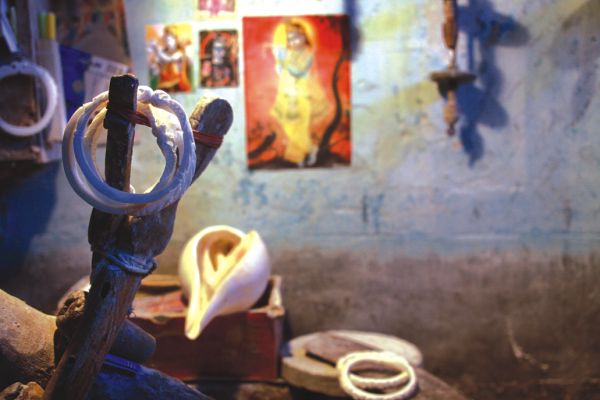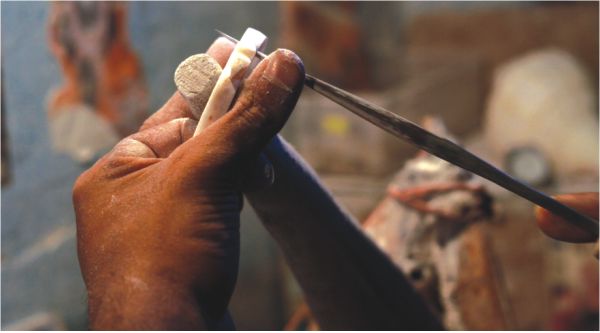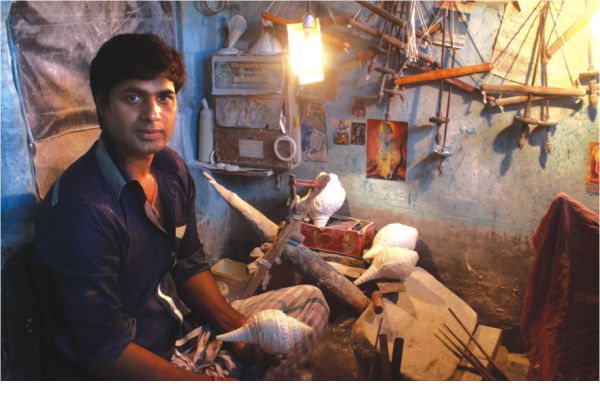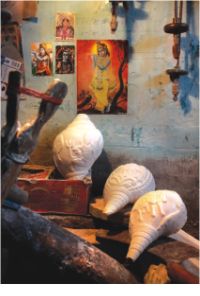Young Crafts

The shakharee community borrows their title from the word 'shakha'- white bangle.
Portrait of A Young Artist
Saad Adnan Khan
Photos: Kazi Tahsin Agaz Apurbo
Inside the 200 year old building at Shakhari Bazaar, 28-year-old Bappi Nag stoops over his craftwork. This workshop, on the third floor that one reaches after climbing a dark, narrow, steep winding staircase is where Bappi works every morning. He works all day long. Instruments hang on the wall right across where he sits. Designs and motifs that occupy his imagination, he lays them all down in intricate details over the white matte surface of the shankha (conch shell). Other times, he would work on shakha, bangles that married Hindu women wear, to express their marital status. In either case, he would carve out faces of elephants and peacocks, sceneries of villages and beautiful patterns using sharp files. For the last 15 years, Bappi Nag has been involved with this artwork that speaks of religion, culture and history.

Bappi Nag's labour and craft is endearing.
Shakhari Bazar in old Dhaka has a different smell altogether. You can almost feel the warmth. Smells from dhoop and incense in temples, the food from the stores and flowers hanging out, all combine and hang underneath the cobweb of electric wires overhead. Old buildings, dating back from the Mughal and colonial periods, line the lane, stooping over like old people, holding ancient stories to spill. The name of the moholla is christened after the Shakharees, who settled in this part of the city hundreds of years back. The community borrows the title from the word shakha-- the white bangles made from the slices of shankhas. Shankhas are vital elements used during the pujas by Hindus-- vadya shankha is used as a trumpet, while jal-shankha to offer holy water to the deities and for other decorative ornaments. The shakha craftsmen detail out faces and bodies of Hindu gods and goddesses over the shankha. Shakhari Bazar has the largest number of Hindus in Dhaka.

Bappi Nag-- the young shakha artist inside his workshop.
| |
 |
| |
Shankhas designed by Bappi Nag. |
Shakha craftwork is one of the art forms that escape our eyes and attention in the current times. Most shakha craftsmen rely on acid or other machineries to create their artworks on shakhas and shankha, saving time and earning quick money. Bappi Nag, however, does his artwork manually. He brings out the appropriate file from inside the chunga, a thick bamboo stick that acts as a container. An interesting looking small structure made of woods and sticks, acts as the easel. It is balanced and kept in place with the help of shila pata. Bappi places the bangle on the easel and uses the file to smoothen the surface and dig out feathers of peacock. He uses deral to drill holes and shape out a pattern. He puts in labour, hours after hours behind one pair of shakha. Through his silent labour and dedication, he in a way trumps the capitalist mechanism that objectifies and 'commodifies' human labour. His craft and labour is his resistance.
“You can't do everything using machines. Some things need to be left for the hands. I usually take a day to complete working on a pair of shakhas. But there were days when I took 15 days stretch to work on one single pair. This kind of crafting requires a lot of patience,” says Nag. Nag also adds that the raw materials come from Sri Lanka.

Bappi Nag's designs on shakha bangles.
Bappi Nag studied till the eighth grade in Pogose School in Old Dhaka. After that, he dropped out and joined his father's company of shakha crafting. His father taught him the entire art of shakha craftwork, and since then, he has been carrying forth the legacy of his family (His grandfather was a shakha craftsman too). Bappi's father went to Sonargaon last month to carry out an exhibition of Bappi's works. Bappi is working on some more upcoming exhibitions. In 2005, he also won the National Award for his crafts from Bangladesh Jadughar Shilpi Shangstha.
| |
 |
| |
A raw shankha from Sri Lanka. |
“A lot of the time, the work might get monotonous. But then again, it's difficult to stop once I'm in my zone. I don't do any work other than this, and I don't feel the need to. This is my life, and I plan on building a future out of this,” expresses Nag.
Shakha art is a neglected art form, and the shakha artists and craftsmen earn very low income. Given that Bappi Nag mainly works with his own designs, he expresses content, sitting inside the small workshop. He says that he loves working here. A canopy of leaves droops over the window of his workshop. It is difficult to imagine Bappi Nag working somewhere else, but here.
| 